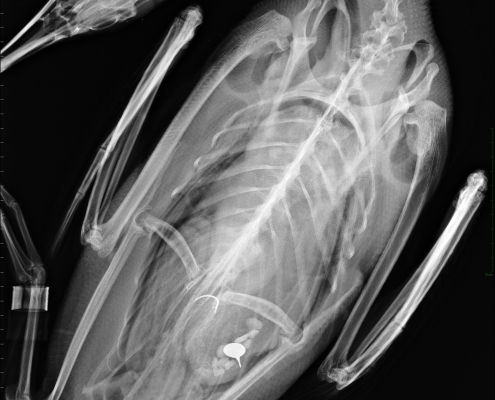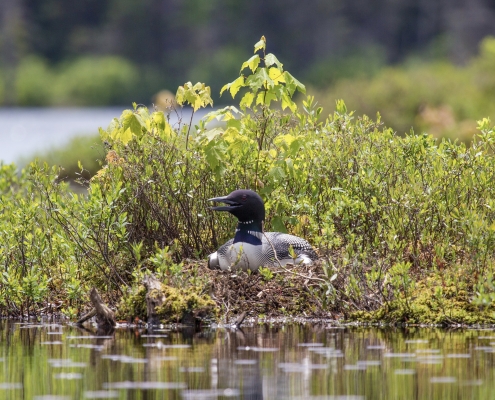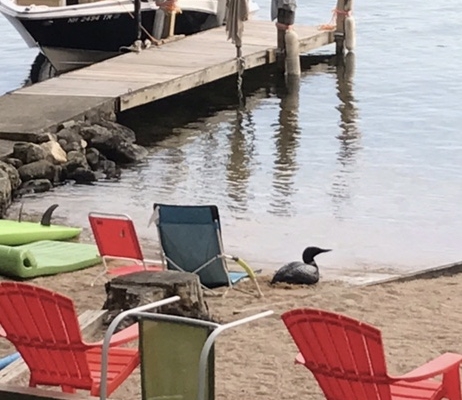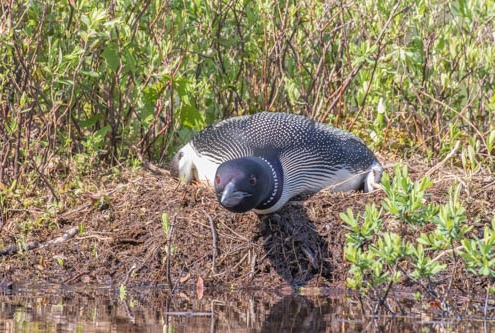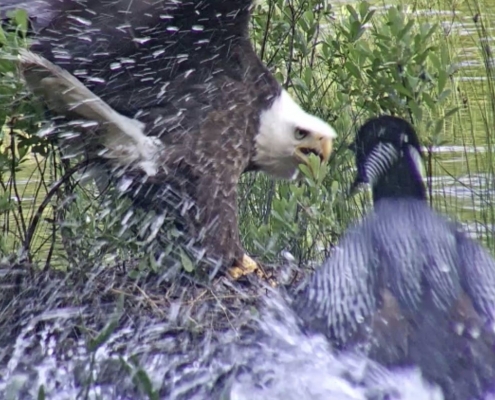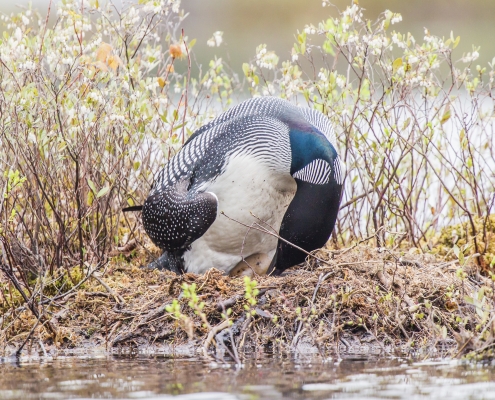Climate Change
Like many other avian species, loons are expected to be greatly affected by climate change in the coming decades. Changing temperature and precipitation patterns may pose a threat to loons, particularly during the nesting period. High temperatures can stress loons on the nest, and rain events can flood nests. LPC has found that breeding success, as measured by the number of chicks hatched per nesting loon pair, has declined as temperatures and rainfall have increased in New Hampshire. If further increases in temperatures and rainfall predicted by climate change models are accurate, these and a range of other possible effects of climate change will increasingly challenge New Hampshire’s loons.
Shoreline Development
Loons build their nests on the shorelines or islands of lakes and ponds—the same areas that humans like to develop for residential or recreational purposes. As a result, human development has drastically reduced loon nesting habitat on many lakes and ponds in New Hampshire and in other states. Click here to learn about how LPC’s nest rafts help to provide new nesting habitat for loons on developed lakes.
Video courtesy of John Rockwood.
Water Level Fluctuations
Because loons cannot walk well on land, they build their nests right at the water’s edge. This leaves nests vulnerable to natural or human-induced water level changes that can flood nests or leave them stranded out of reach of incubating loons. Click here to learn about how LPC’s nest rafts help to address this challenge.
Predation
As human populations have increased around our lakes and ponds, so have the populations of raccoons, gulls, and other scavengers due to the availability of garbage as a food source. Many of these animals are opportunistic predators of loon eggs. LPC’s nest rafts help to reduce egg predation from raccoons and other animals.
Human Recreational Pressure
Because loons cannot walk upright, they are vulnerable while on land. This means that while nesting, they often flush from the nest into the water if they perceive a nearby threat. Close approach by humans can trigger this response in incubating loons, leaving eggs unattended and vulnerable to predation, overheating, or chilling. LPC’s protective signs help to address this problem.
Fishing Line Entanglement
Fishing line entanglement is another threat to loons that results from human recreational activities. Loons may become entangled if they catch a fish that has broken an angler’s line or if they encounter loose fishing line in the water or along the shoreline. If the line is wrapped around a foot, wing, or other body part that is not the bill, loons are sometimes able to shake it off without help; however, if line becomes wrapped around a loon’s bill, it makes it difficult for the loon to eat or preen. This can lead to rapid deterioration in the loon’s physical state. LPC staff often rescue tangled loons.
Video courtesy of John Rockwood.
Eagle Predation
New Hampshire’s Bald Eagle population has grown rapidly over the past decade, and reports of eagles harassing loon families and predating loon chicks have increased in recent years. In 2019, our Live Loon Cam captured footage of an eagle predating a newly hatched loon chick. For those interested, the video can be found here (warning: content may disturb some viewers).
While LPC does attach overhead covers to our nest rafts in order to provide protection to nesting loons and newly hatched chicks, we do not interfere in instances of eagle harassment. Instead, our efforts are directed towards human-caused threats to loons, which have a far greater negative impact on the population than natural threats like eagles.
Contaminants
Chemical contaminants have been shown to cause a variety of harmful health and reproductive effects to several bird species, including reducing the likelihood of eggs successfully hatching. Although many contaminants have been banned for decades, these chemicals do not break down readily in the environment and persist in aquatic food chains, continuing to impact birds and other wildlife. New contaminants are introduced to the environment as well. The impacts of these contaminants on loons are not well understood but are likely similar to other birds; and, as a fish-eating bird at the top of aquatic food chains, loons are important indicators of levels of these contaminants in the environment. LPC tests unhatched loon eggs from failed nests for a variety of contaminants, including PBDEs (flame retardants), PFAS contaminants (stain guards, firefighting foam), PCBs (industrial insulating/cooling agents), DDT and chlordane (pesticides), dioxins and furans (byproducts of industrial processes), and trace metals, including mercury.
Fireworks
Little is currently known about the impacts of fireworks displays on loons. LPC’s live loon cams and game cameras have so far not detected any negative impacts of fireworks on loon nest attendance behavior; however, it is important to note that our data are from a limited number of loons. Behavioral impacts may vary by individual loon or by distance from the fireworks, and as such we cannot claim that fireworks have no impacts on nesting loon behavior.

